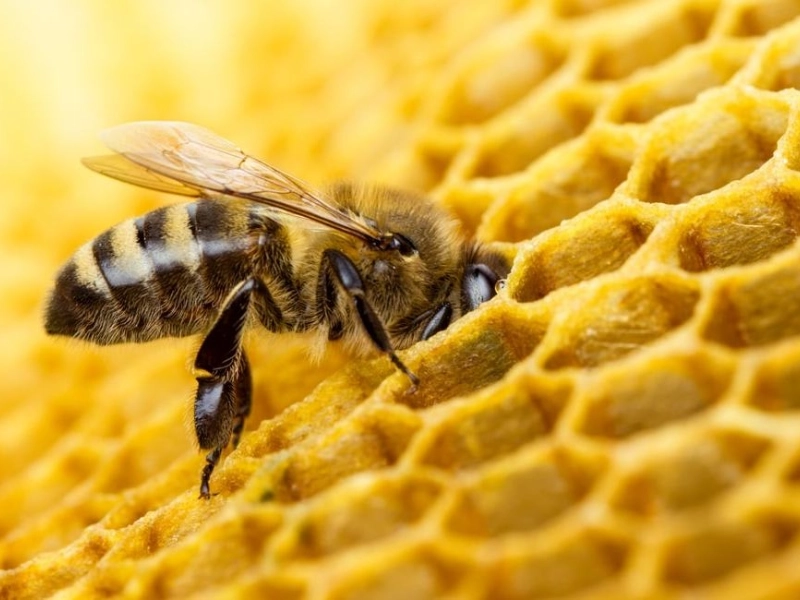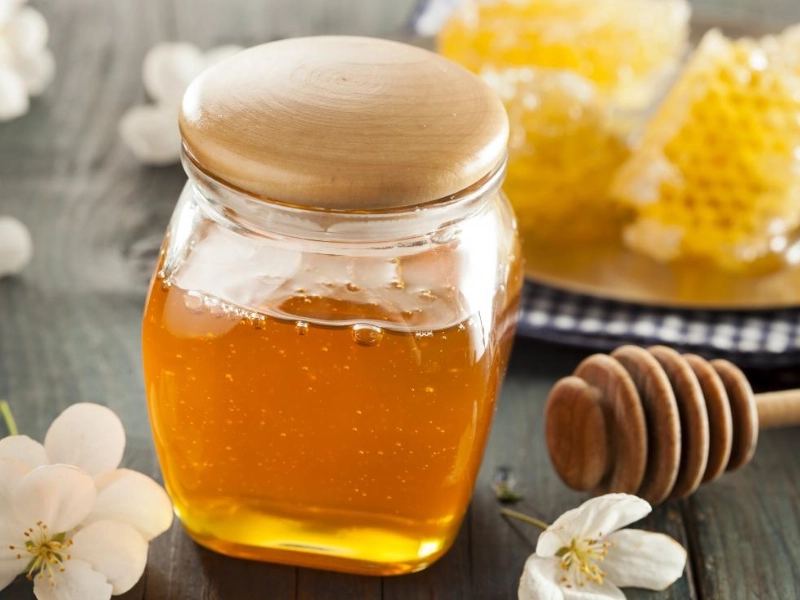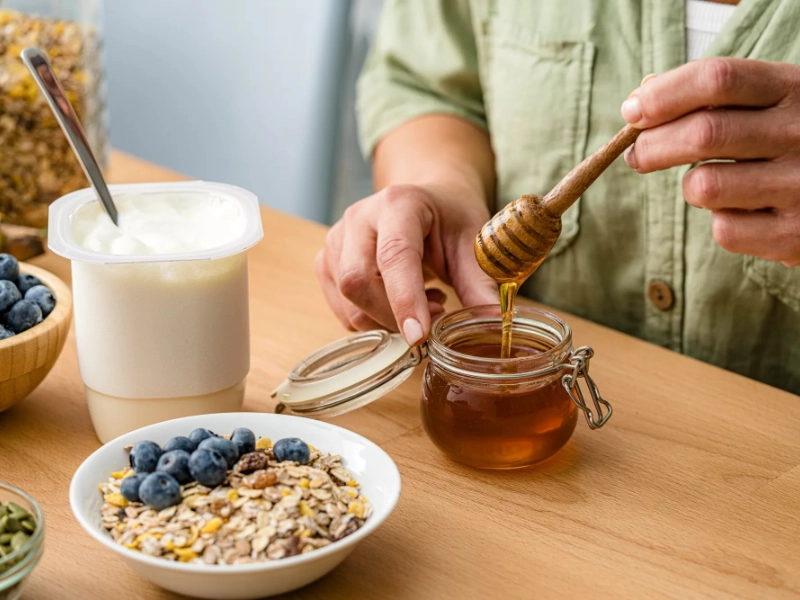Honey is widely recognized for its healing properties, including its ability to heal wounds, soothe sore throats, and aid digestion. It is also packed with a variety of nutrients, such as phenolic acids, peptides, Maillard reaction products, amino acids, vitamins (including all water-soluble ones), minerals, and enzymes. Historically, honey has served as a natural remedy, and there is evidence supporting many of its traditional applications, particularly in the treatment of infections.

 Honey is a viscous substance produced by bees (*Apis mellifera*) from plant nectar or honeydew. It has been used for nutritional, cosmetic, and medicinal purposes since ancient times. Modern research is increasingly supporting many of honey’s historical uses, particularly in terms of microbial inhibition and wound healing.
The main components of honey include sugars (glucose and fructose in equal ratios), water, and other constituents (approximately 3%), which encompass flavonoids, phenolic compounds, prebiotics (such as *lactobacillus acidophilus*), amino acids, vitamins (especially vitamin C and the B vitamins), minerals, and enzymes.
Research suggests that the phenolic constituents of honey have immunomodulatory effects. For instance, honey has been shown to inhibit LPS-induced release of TNF-a, IL-1b, and IL-6 in macrophages, as well as suppressing the activation of extracellular signal-regulated kinases and mitogen-activated protein kinases in monocytes. These effects may help reduce inflammatory responses in the body and lessen immune-related side effects from cancer treatments.
Honey is a viscous substance produced by bees (*Apis mellifera*) from plant nectar or honeydew. It has been used for nutritional, cosmetic, and medicinal purposes since ancient times. Modern research is increasingly supporting many of honey’s historical uses, particularly in terms of microbial inhibition and wound healing.
The main components of honey include sugars (glucose and fructose in equal ratios), water, and other constituents (approximately 3%), which encompass flavonoids, phenolic compounds, prebiotics (such as *lactobacillus acidophilus*), amino acids, vitamins (especially vitamin C and the B vitamins), minerals, and enzymes.
Research suggests that the phenolic constituents of honey have immunomodulatory effects. For instance, honey has been shown to inhibit LPS-induced release of TNF-a, IL-1b, and IL-6 in macrophages, as well as suppressing the activation of extracellular signal-regulated kinases and mitogen-activated protein kinases in monocytes. These effects may help reduce inflammatory responses in the body and lessen immune-related side effects from cancer treatments.
 Honey has been widely used in ancient medicine as an effective natural remedy and a healthy sweetener. It is rich in various phytochemicals and is known to exhibit anti-inflammatory effects.
The antioxidant properties of honey are primarily attributed to its polyphenol content, which includes flavonoids (such as apigenin, pinocembrin, kaempferol, and quercetin), phenolic acids (like ellagic acid, caffeic acid, and p-coumaric acid), and amino acids (such as proline and sylvaline).
Inflammation is a significant factor in chronic diseases. Recent studies have indicated that honey possesses anti-inflammatory properties by inhibiting the oxidation of LDL cholesterol in humans. Furthermore, honey has been shown to prevent inflammatory responses in patients with bronchial asthma. Additional research is required to determine whether these anti-inflammatory benefits can be applied to other clinical disorders.
Honey has been widely used in ancient medicine as an effective natural remedy and a healthy sweetener. It is rich in various phytochemicals and is known to exhibit anti-inflammatory effects.
The antioxidant properties of honey are primarily attributed to its polyphenol content, which includes flavonoids (such as apigenin, pinocembrin, kaempferol, and quercetin), phenolic acids (like ellagic acid, caffeic acid, and p-coumaric acid), and amino acids (such as proline and sylvaline).
Inflammation is a significant factor in chronic diseases. Recent studies have indicated that honey possesses anti-inflammatory properties by inhibiting the oxidation of LDL cholesterol in humans. Furthermore, honey has been shown to prevent inflammatory responses in patients with bronchial asthma. Additional research is required to determine whether these anti-inflammatory benefits can be applied to other clinical disorders.
 For thousands of years, honey has been employed to treat wounds and burns. A 2017 study found that honey and bee propolis exhibit antibacterial properties and assist in microbial inhibition and wound healing. It is crucial to use raw honey that has not been pasteurized, as regular store-bought honey may contain high fructose corn syrup; therefore, checking the label is important. It is also vital to note that honey should not be used for serious burns, as it does not provide the same level of protection as medical-grade burn treatments.
Ancient texts document the medicinal uses of honey, including references in Sumerian clay tablets (6200 B.C.), the Veda (around 5000 B.C.), Egyptian papyrus, the Talmud, and the Bible (both Old and New Testaments). Applying honey to burns can stimulate wound healing and sterilize the skin. It also alleviates pain and has been used to treat severe burns, bedsores, and diabetic foot ulcers.
For thousands of years, honey has been employed to treat wounds and burns. A 2017 study found that honey and bee propolis exhibit antibacterial properties and assist in microbial inhibition and wound healing. It is crucial to use raw honey that has not been pasteurized, as regular store-bought honey may contain high fructose corn syrup; therefore, checking the label is important. It is also vital to note that honey should not be used for serious burns, as it does not provide the same level of protection as medical-grade burn treatments.
Ancient texts document the medicinal uses of honey, including references in Sumerian clay tablets (6200 B.C.), the Veda (around 5000 B.C.), Egyptian papyrus, the Talmud, and the Bible (both Old and New Testaments). Applying honey to burns can stimulate wound healing and sterilize the skin. It also alleviates pain and has been used to treat severe burns, bedsores, and diabetic foot ulcers.